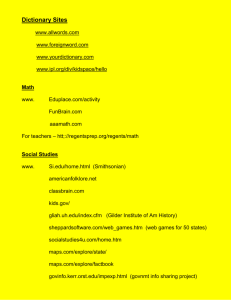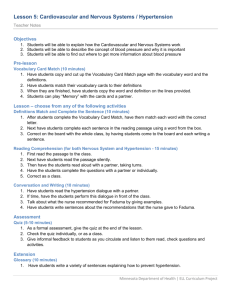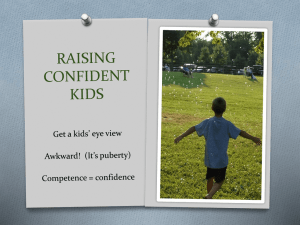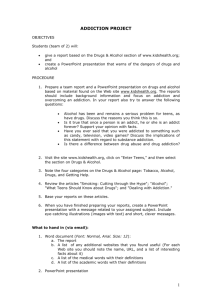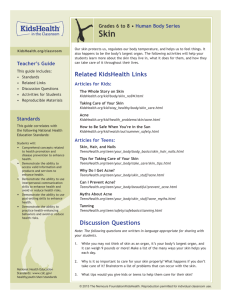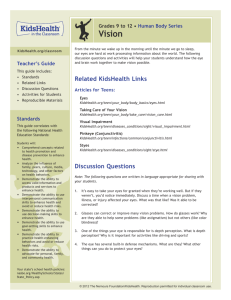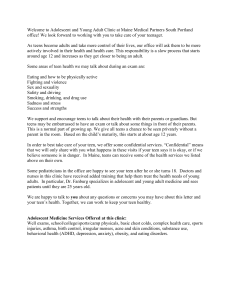Teacher's Guide: Obesity (Grades 9 to 12)
advertisement
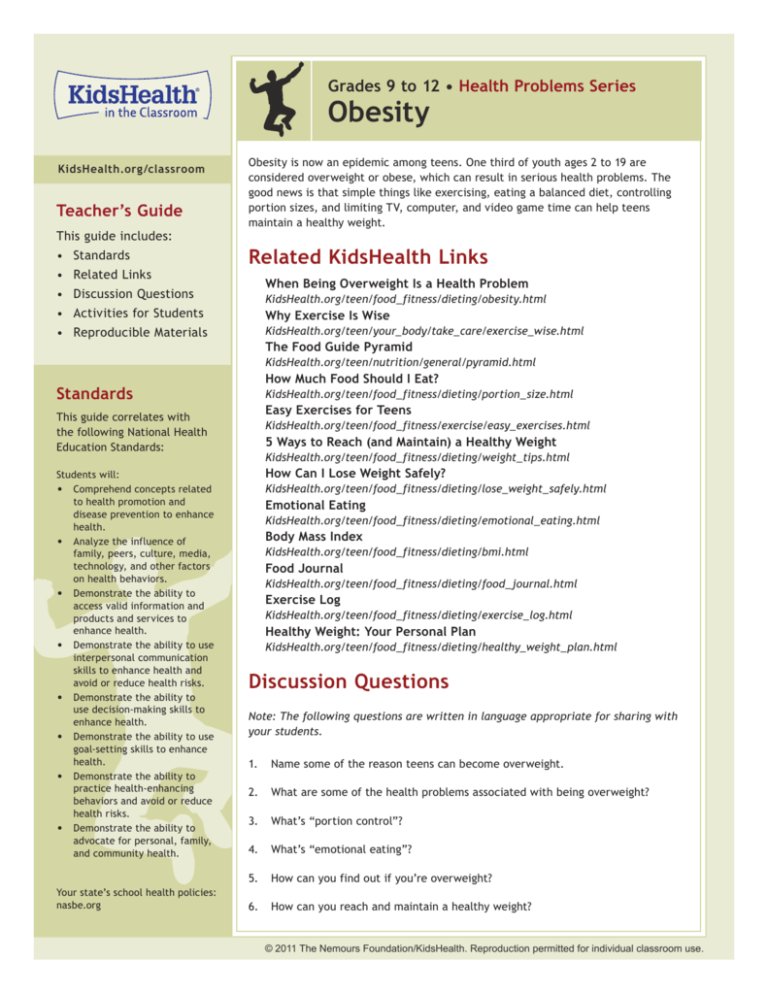
Grades 9 to 12 • Health Problems Series Obesity KidsHealth.org/classroom Teacher’s Guide This guide includes: • Standards • Related Links • Discussion Questions • Activities for Students • Reproducible Materials Obesity is now an epidemic among teens. One third of youth ages 2 to 19 are considered overweight or obese, which can result in serious health problems. The good news is that simple things like exercising, eating a balanced diet, controlling portion sizes, and limiting TV, computer, and video game time can help teens maintain a healthy weight. Related KidsHealth Links When Being Overweight Is a Health Problem KidsHealth.org/teen/food_fitness/dieting/obesity.html Why Exercise Is Wise KidsHealth.org/teen/your_body/take_care/exercise_wise.html The Food Guide Pyramid KidsHealth.org/teen/nutrition/general/pyramid.html Standards This guide correlates with the following National Health Education Standards: Students will: • Comprehend concepts related to health promotion and disease prevention to enhance health. • Analyze the influence of family, peers, culture, media, technology, and other factors on health behaviors. • Demonstrate the ability to access valid information and products and services to enhance health. • Demonstrate the ability to use interpersonal communication skills to enhance health and avoid or reduce health risks. • Demonstrate the ability to use decision-making skills to enhance health. • Demonstrate the ability to use goal-setting skills to enhance health. • Demonstrate the ability to practice health-enhancing behaviors and avoid or reduce health risks. • Demonstrate the ability to advocate for personal, family, and community health. How Much Food Should I Eat? KidsHealth.org/teen/food_fitness/dieting/portion_size.html Easy Exercises for Teens KidsHealth.org/teen/food_fitness/exercise/easy_exercises.html 5 Ways to Reach (and Maintain) a Healthy Weight KidsHealth.org/teen/food_fitness/dieting/weight_tips.html How Can I Lose Weight Safely? KidsHealth.org/teen/food_fitness/dieting/lose_weight_safely.html Emotional Eating KidsHealth.org/teen/food_fitness/dieting/emotional_eating.html Body Mass Index KidsHealth.org/teen/food_fitness/dieting/bmi.html Food Journal KidsHealth.org/teen/food_fitness/dieting/food_journal.html Exercise Log KidsHealth.org/teen/food_fitness/dieting/exercise_log.html Healthy Weight: Your Personal Plan KidsHealth.org/teen/food_fitness/dieting/healthy_weight_plan.html Discussion Questions Note: The following questions are written in language appropriate for sharing with your students. 1. Name some of the reason teens can become overweight. 2. What are some of the health problems associated with being overweight? 3. What’s “portion control”? 4. What’s “emotional eating”? 5. How can you find out if you’re overweight? Your state’s school health policies: nasbe.org 6. How can you reach and maintain a healthy weight? © 2011 The Nemours Foundation/KidsHealth. Reproduction permitted for individual classroom use. Grades 9 to 12 • Health Problems Series Obesity Activities for Students Note: The following activities are written in language appropriate for sharing with your students. 5 Texts for Teens Objectives: Students will: • Identify five ways teens can make healthy choices about eating and staying active • Create five catchy text message slogans that can be sent to teens about exercising, eating right, and limiting screen time Materials: • • • KidsHealth articles related to obesity Writing materials, computer “5 Texts for Teens” handout Class Time: Two hours Activity: You’ve convinced the president that texting is the best way to reach teens about nutrition and fitness and help beat obesity. As the nation’s first Teen Nutrition and Fitness Czar, you’re going to create five tips that can be texted to teens across America to remind them about staying healthy. To begin your research, read these KidsHealth articles related to obesity: “When Being Overweight Is a Health Problem,” “5 Ways to Reach (and Maintain) a Healthy Weight,” “Why Exercise Is Wise,” “The Food Guide Pyramid,” “How Much Food Should I Eat?” “Easy Exercises for Teens,” and “How Can I Lose Weight Safely?” Now, create five text messages that the White House can send to teens’ cell phones on a regular basis to remind them about making healthy choices. Try your best to make the texts memorable and catchy so they’ll go viral. Be sure to include a symbol, icon, or image with each text, in case it winds up being the title of an app that teens can download. Extension: 1. You’ve read a lot of KidsHealth articles related to nutrition and fitness, and now it’s time to get the message out to the rest of your school. With a partner or in small group, create a public service announcement that can be read over the school loudspeaker to help students reach and maintain a healthy weight. Include five easy-toremember tips that you think would help teens. Make sure the announcement is not longer than 1 minute. © 2011 The Nemours Foundation/KidsHealth. Reproduction permitted for individual classroom use. Grades 9 to 12 • Health Problems Series Obesity Don’t Supersize Me Objectives: Students will: • Understand the concept of portion control • Learn how to apply the divided plate and other portion control tips to their own eating habits Materials: • • • KidsHealth article “How Much Food Should I Eat?” “Don’t Supersize Me” handout Art supplies (markers, colored pencils), magazines, grocery store advertisement circulars Class Time: • One hour Activity: Teens eat more today than they used to, and more than they need to. One reason obesity is an epidemic among teens is because food portions are larger. Teens who frequently eat these large portions are more likely to become overweight and develop serious health problems. Read the KidsHealth article “How Much Food Should I Eat?” Then think about how you can downsize your meals to the real size you need. Now you’re ready to create a mini-poster to hang in your kitchen or eating area to help you remember these tips. The divided plate concept you read about not only helps keep portions to a healthy size, but also reminds you to eat a variety of foods. On the handout, label and illustrate the four sections on the blank plate. Then, list four portion control tips that you can use at home during meals. Extensions: 1. Create large portion control posters for the school cafeteria based on the divided plate concept. 2. Record the foods you eat and your thoughts and feelings using the KidsHealth printable “Food Journal.” Reproducible Materials Handout: 5 Texts for Teens KidsHealth.org/classroom/9to12/problems/conditions/obesity_handout1.pdf Handout: Don’t Supersize Me KidsHealth.org/classroom/9to12/problems/conditions/obesity_handout2.pdf Quiz: Obesity KidsHealth.org/classroom/9to12/problems/conditions/obesity_quiz.pdf Answer Key: Obesity KidsHealth.org/classroom/9to12/problems/conditions/obesity_quiz_answers.pdf KidsHealth.org is devoted to providing the latest children’s health information. The site, which is widely recommended by educators, libraries, and school associations, has received the “Teachers’ Choice Award for the Family” and the prestigious Pirelli Award for “Best Educational Media for Students.” KidsHealth comes from the nonprofit Nemours Foundation. Check out www.KidsHealth.org to see the latest additions! © 2011 The Nemours Foundation/KidsHealth. Reproduction permitted for individual classroom use. Health Problems Series Obesity Name: Date: 5 Texts for Teens Instructions: As the nation’s first Teen Nutrition and Fitness Czar, you’ve been asked by the president to write five catchy and memorable text message slogans that can be sent to teens across the country to remind them about reaching and staying at a healthy weight. Be sure to create a symbol, icon or graphic image to accompany each text message. N NUTRITION TEE an AR d F IT N E SS C Z © 2011 The Nemours Foundation/KidsHealth. Reproduction permitted for individual classroom use. Health Problems Series Obesity Name: Date: N NUTRITION TEE an AR d F IT N E SS C Z © 2011 The Nemours Foundation/KidsHealth. Reproduction permitted for individual classroom use. Health Problems Series Obesity Name: Date: N NUTRITION TEE an AR d F IT N E SS C Z © 2011 The Nemours Foundation/KidsHealth. Reproduction permitted for individual classroom use. Health Problems Series Obesity Name: Date: N NUTRITION TEE an AR d F IT N E SS C Z © 2011 The Nemours Foundation/KidsHealth. Reproduction permitted for individual classroom use. Health Problems Series Obesity Name: Date: N NUTRITION TEE an AR d F IT N E SS C Z © 2011 The Nemours Foundation/KidsHealth. Reproduction permitted for individual classroom use. Health Problems Series Obesity Name: Date: Don’t Supersize Me Instructions: Label the four sections of the divided plate and illustrate each section with an example of a food that fits in each section. Then list four portion control tips to help you avoid getting supersized. The divided plate: Portion control tips: 1. 2. 3. 4. © 2011 The Nemours Foundation/KidsHealth. Reproduction permitted for individual classroom use. Health Problems Series Obesity Name:Date: Quiz Instructions: Answer each question. 1. True or False: One in three youth ages 2 to 19 are overweight or obese. T F 2. Draw and label the four sections of the divided plate concept: 3. True or False: Eating food on a smaller plate can help with portion control. T F 4. Name three health problems that are caused by being overweight: 5. Name two reasons why some teens become overweight: 6. A teen is considered overweight when his or her BMI is equal to or greater than the percentile for age and gender. 7. A teen is considered obese when his or her BMI is percentile and less than the percentile or higher for age and gender. 8. Name five things teens can do to reach and maintain a healthy weight: 9. Teens should exercise at least minutes a day. 10. Screen time should be limited to less than hours a day. © 2011 The Nemours Foundation/KidsHealth. Reproduction permitted for individual classroom use. Health Problems Series Obesity Quiz Answer Key 1. True or False: One in three youth ages 2 to 19 are overweight or obese. T F 2. Draw and label the four sections of the divided plate concept: plate with four quarters labeled protein, starch, vegetable, vegetable 3. True or False: Eating food on a smaller plate can help with portion control. T F 4. Name three health problems that are caused by being overweight: Any three of the following: high blood pressure, high cholesterol, diabetes, sleep apnea, gallstones, arthritis, asthma, hip and knee problems, fatty liver, depression, polycystic ovary syndrome 5. Name two reasons why some teens become overweight: Any two of the following: genes, eat more calories than they burn, poor food choices and eating patterns, too much screen time, emotional reasons, not enough activity, large food portions 6. A teen is considered overweight when his or her BMI is equal to or greater than the percentile for age and gender. 7. A teen is considered obese when his or her BMI is 95 85 percentile and less than the 95 percentile or higher for age and gender. 8. Name five things teens can do to reach and maintain a healthy weight: Exercise, reduce screen time, portion control, eat a variety of foods, eat breakfast 9. Teens should exercise at least 60 minutes a day. 10. Screen time should be limited to less than 2 hours a day. © 2011 The Nemours Foundation/KidsHealth. Reproduction permitted for individual classroom use.
